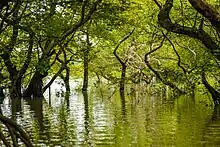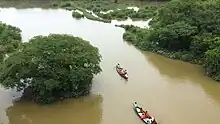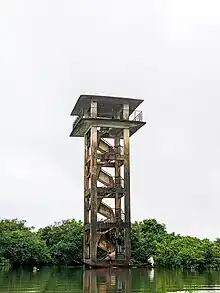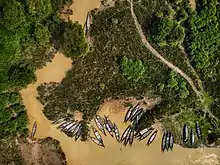
Ratargul Swamp Forest (Bengali: রাতারগুল জলাবন) is a freshwater swamp forest located in Gowain River, Fatehpur Union, Gowainghat, Sylhet, Bangladesh. Ratargul was once thought to be the only swamp forest in Bangladesh,[1][2][3] and one of the few freshwater swamp forests in the world. Later, more swamp forests namely Jugirkandi Mayabon, Bujir Bon and Lokkhi Baor swamp forest were discovered in Bangladesh.[4][5][6] The forest is naturally conserved under the Department of Forestry, Government of Bangladesh.
Its area is 3,325.61 acres (1,345.83 ha) including 504 acres (204 ha) declared as the animal sanctuary in 2015. It is known as the Sundarbans of Sylhet. This is only swamp forest in Bangladesh, located 26 kilometres (16 mi) from Sylhet. The forest's name comes from the word "Rata" or "Pati" tree used by the locals of Sylhet.
The evergreen forest[7] is situated by the river Goain and linked with the channel Chengir Khal. Most of the trees growing here are the Dalbergia reniformis (করচ গাছ Koroch tree). The forest is submerged under 20–30 ft (6.1–9.1 m) water in the rainy season. For the rest of the year, the water level is about 10 ft (3.0 m) deep.[8][9][10]
Location


Ratargul is about 26 kilometres from Sylhet. There is a 3,325 acres wetland in Sylhet range-2 under the forest department and in that wetland Ratargul swamp forest is about 504 acres[11] It is located in Gowainghat. After reaching Gowainghat, tourists reserve local engine boat namely "traller" to reach forest.[12] There are two haors, Shimul Bil haor and Neoa Bil Haor, in the south part of the forest.[13]
Climate
Tropical air from the northwest of Sylhet causes heavy rainfall. According to Sylhet Weather Centre, average annual rainfall is 4,162 mm (163.9 in). July hosts the most rainfall, with measures averaging 1,250 mm (49 in). December is the driest season with 74% relative density, compared to more than 90% in July and August. The forest is linked with the Gowain River through the lake Chengir Khal. During the rainy season, water from India overflows into the lake from the Gowain River and the forest becomes flooded. This continues through the wet season from May to early October. During this time of the year, the average high temperature hits 32 °C (90 °F), and in January, the coolest month, the average high sits around 12 °C (54 °F). During the rainy season, the trees of the swamp submerge about 10 ft (3.0 m) and in some cases up to 20 ft (6.1 m) under water, but the forest emerges during the dry season.[14][15]
Plant diversity

73 species of plants could be found in the forest till now. 80 percent of the forest area is covered with umbrella of the trees.[14]
Two layers of plants can be seen in the swamp forest. The upper layer consists of trees and the lower one consists of intense Schumannianthus dichotomus. The forest canopy reaches up to 15 m (49 ft) tall.
Though the forest is natural, the Forestry Department of Bangladesh has planted some watery plants like Calamus tenuis, Neolamarckia cadamba, Barringtonia acutangula, Calamus tenuis. Banyan Tree is very common in the forest. Besides that, Barringtonia acutangula, Dalbergia reniformis, Crateva religiosa or Hygrophila (plant), Alstonia scholaris can also be seen.[16]
Animal diversity
Snakes and worm snakes can widely be seen in this water-drowned forest. Mongoose can be seen in dry season. Monkeys and water monitors also reside here. herons, egrets, kingfishers, parrot, bulbuls, swans, doves, water fowl, wagles and kites are some of the birds of the swamp forest. cotton pygmy Goose and other migratory birds and vultures visit the forest in winter. The local names of fish present here are Batasio, Rita, Pabda, Rohu etc.[16]
Tourists attraction

Tourists mostly go to see the forest in monsoon. One needs to take permission from the forest office to visit the forest. A local boat needs to be hired to travel through the swamp forest. There is a building tower inside the forest. If you go up there, you can see the whole view of the forest.
Gallery
 Children in a boat on the Shari-Goyain River in Ratargul Swamp Forest
Children in a boat on the Shari-Goyain River in Ratargul Swamp Forest


See also
References
- ↑ "রাতারগুলকে ছাড়িয়ে জুগিরকান্দি 'মায়াবন'". Somoy TV. 1 October 2016. Retrieved 11 August 2022.
- ↑ "বাংলাদেশের একমাত্র জলাবন রাতারগুল". Deutsche Welle . 16 July 2014. Retrieved 11 August 2022.
- ↑ "জলাবন রাতারগুল". bdnews24.com. 11 August 2014. Retrieved 11 August 2022.
- ↑ "মায়াবন". Prothom Alo. 27 September 2016. Retrieved 11 August 2022.
- ↑ "সিলেটে নতুন পর্যটন স্পট বুজির বন". Daily Naya Diganta. 18 August 2019. Retrieved 8 August 2022.
- ↑ "লোকচক্ষুর আড়ালে রাতারগুলের চেয়েও বড় ও প্রাচীন জলাবন লক্ষ্মীবাওর". Kaler Kantho. 3 December 2020. Retrieved 8 August 2022.
- ↑ "The land found in the haors". Retrieved 12 September 2016.
- ↑ "Ratargul Swamp forest – Bangladesh". Retrieved 12 September 2016.
- ↑ "Ratargul: Only swamp forest in Bangladesh". Daily Sun. 13 May 2012. Archived from the original on 15 May 2014.
- ↑ "Ratargul swamp forest – World Tourism Day". Retrieved 12 September 2016.
- ↑ Amazon of Bangladesh
- ↑ "Ratargul Swamp Forest in Bangladesh – traveling FAQs". 2 October 2012. Retrieved 12 September 2016.
- ↑ Swamp Forest Ratargul, Istiak Hasan; spotlight, Daily Kaler Kantho; Publish date: 28 August 2011. Access date: 13 October 2015.
- 1 2 Chowdhury, Junayed K. (2004). Biodiversity of Ratargul Swamp Forest, Sylhet. IUCN The World Conservation Union. OCLC 255416492.
- ↑ Ratargul Swamp Forest climate
- 1 2 Ishtiaque Hasan (28 August 2011). জলের বন রাতারগুল. Kaler Kantho (in Bengali).